Flipped Learning in Engineering Modules Is More Than Watching Videos: The Development of Personal and Professional Skills
Abstract
1. Introduction
“Flipped Learning is a pedagogical approach in which first contact with new concepts moves from the group learning space to the individual learning space in the form of structured activity, and the resulting group space is transformed into a dynamic, interactive learning environment where the educator guides students as they apply concepts and engage creatively in the module matter… So the physical space for a flipped learning course has to enable active learning and allow for a variety of student choices in how they engage in this”.[32]
2. Background
2.1. Some Required Transversal Competences in Engineering Instruction
- Reading comprehension
- Writing skills
2.2. Opportunities and Risks of Online Teaching
- Student engagement
- Evaluation
3. Materials and Methods
3.1. UPM
3.2. UJA
3.3. UDEP
4. Results
4.1. Students’ Use and Perception of Videos and Other Flipped Learning Materials
4.2. Students’ Engagement with the Modules
4.3. Students’ Performance in Writing
5. Discussion
6. Conclusions
- Flipped teaching should not be limited to preparing videos, since the pure watching activity hinders the achievement of various outcomes in case there are no other activities to guide and engage students, such as achieving critical thinking and other higher-order thinking skills—in accordance with Bloom’s taxonomy: application, analysis, synthesis and evaluation.
- Some outcomes may have been losing the spotlight: the comprehension reading and the functional writing skills, which are the cornerstones of the outcomes prescribed by ABET for engineering students, the ability to communicate effectively with a range of audiences, and the ability to acquire and apply new knowledge as needed, using appropriate learning strategies.
- Student engagement is crucial for a good performance of flipped learning techniques. When the students are motivated and engaged with the learning process, their daily work is of better quality and, if the flipped learning techniques include writing and comprehension skills, these skills are trained and improved.
- The experience has shown that students that had completed almost the whole degree (four years) with in-person classes, could shift to an online system with relatively good performance, although they were not used to those formats. Indeed, such a change even increased their digital skills.
- On the contrary, those students that have performed their recent studies on virtual supports face what could be named as ICT-tiredness (Information and Communications Technology). Moreover, this has deepened the lack of vocabulary and reading skills produced by the new supports, such as Twitter or WhatsApp, getting them used to short, fast, and very simple messages.
- These learner-centered strategies can help students to learn better, comprehend, apply, and transmit a module’s core tenets to new situations.
- Organizing the module using a visual guide is a beneficial practice for interacting with students and clarifying expectations. Chunking the syllabus content into units reduces cognitive load in favor of emphasizing the core concepts that students need to apply in their professional careers.
Author Contributions
Funding
Institutional Review Board Statement
Informed Consent Statement
Data Availability Statement
Conflicts of Interest
References
- Bozhko, Y.V.; Maksimkin, A.I.; Baryshev, G.K.; Voronin, A.I.; Kondratyeva, A.S. Digital transformation as the key to synthesis of educational and innovation process in the research university. In Proceedings of the International Conference on Digital Transformation and Global Society, St. Petersburg, Russia, 22–24 June 2016; pp. 386–391. [Google Scholar] [CrossRef]
- Faria, J.A.; Nóvoa, H. Digital transformation at the University of Porto. In International Conference on Exploring Services Science; Springer: Cham, Switzerland, 2017; pp. 295–308. [Google Scholar] [CrossRef]
- Gaivoronskii, D.V.; Kutuzov, V.M.; Minina, A.A. Digital transformation of engineering education. In Proceedings of the 2017 IEEE VI Forum Strategic Partnership of Universities and Enterprises of Hi-Tech Branches (Science. Education. Innovations) (SPUE), St. Petersburg, Russia, 15–17 November 2017; pp. 3–6. [Google Scholar]
- Safiullin, M.R.; Akhmetshin, E.M. Digital transformation of a university as a factor of ensuring its competitiveness. Int. J. Eng. Adv. Technol. 2019, 9, 7387–7390. [Google Scholar]
- Santos, H.; Batista, J.; Marques, R.P. Digital transformation in higher education: The use of communication technologies by students. Procedia Comput. Sci. 2019, 164, 123–130. [Google Scholar] [CrossRef]
- Henderson, M.; Selwyn, N.; Aston, R. What works and why? Student perceptions of “useful” digital technology in university teaching and learning. Stud. High. Educ. 2017, 42, 1567–1579. [Google Scholar] [CrossRef]
- Bond, M.; Buntins, K.; Bedenlier, S.; Zawacki-Richter, O.; Kerres, M. Mapping research in student engagement and educational technology in higher education: A systematic evidence map. Int. J. Educ. Technol. High. Educ. 2020, 17, 2. [Google Scholar] [CrossRef]
- Ayinla, K.O.; Adamu, Z. Bridging the digital divide gap in BIM technology adoption. Eng. Constr. Archit. Manag. 2018, 25, 1398–1416. [Google Scholar] [CrossRef]
- Coello, J.G.; Salazar, J.T.; Taborda, M.L.N. Peruvian students in pandemic: Digital gap and what is done from engineering programs? In Proceedings of the 2020 IEEE International Symposium on Accreditation of Engineering and Computing Education (ICACIT), Arequipa, Peru, 5–6 November 2020; pp. 1–4. [Google Scholar]
- Rodríguez-Abitia, G.; Martínez-Pérez, S.; Ramirez-Montoya, M.S.; Lopez-Caudana, E. Digital Gap in Universities and Challenges for Quality Education: A Diagnostic Study in Mexico and Spain. Sustainability 2020, 12, 9069. [Google Scholar] [CrossRef]
- García-Alberti, M.; Suárez, F.; Chiyón, I.; Mosquera Feijoo, J.C. Challenges and Experiences of Online Evaluation in Courses of Civil Engineering during the Lockdown Learning Due to the COVID-19 Pandemic. Educ. Sci. 2021, 11, 59. [Google Scholar] [CrossRef]
- Mason, G.; Williams, G.; Cranmer, S. Employability skills initiatives in higher education: What effects do they have on graduate labour market outcomes? Educ. Econ. 2009, 17, 1–30. [Google Scholar] [CrossRef]
- Bybee, R.W. Advancing STEM education: A 2020 vision. Technol. Eng. Teach. 2010, 70, 30. [Google Scholar]
- Lowden, K.; Hall, S.; Elliot, D.; Lewin, J. Employers’ Perceptions of the Employability Skills of New Graduates; University of Glasgow SCRE Centre and Edge Foundation: London, UK, 2011; pp. 1–43. [Google Scholar]
- Carracedo, F.S.; Soler, A.; Martín, C.; López, D.; Ageno, A.; Cabré, J.; García, J.; Gibert, K. Competency maps: An effective model to integrate professional competencies across a STEM curriculum. J. Sci. Educ. Technol. 2018, 27, 448–468. [Google Scholar] [CrossRef]
- Jang, H. Identifying 21st century STEM competencies using workplace data. J. Sci. Educ. Technol. 2016, 25, 284–301. [Google Scholar] [CrossRef]
- ABET (2020): Criteria for Accrediting Engineering Programs, 2019–2020. Available online: https://www.abet.org/accreditation/accreditation-criteria/criteria-for-accrediting-engineering-programs-2019-2020/E001-15-16-EAC-Criteria-03-10-15.pdf (accessed on 16 July 2021).
- Pejcinovic, B. Design of Rubrics for Student Outcomes in 2019–2020 ABET Criteria. In Proceedings of the 43rd International Convention on Information and Communication Technology, Electronics and Microelectronics (MIPRO), Opatija, Croatia, 28 September–2 October 2020. [Google Scholar]
- Handelsman, J.; Ebert-May, D.; Beichner, R.; Bruns, P.; Chang, A.; DeHaan, R.; Wood, W.B. Scientific Teaching. Available online: http://www.palieducationsociety.org/images/ebooks%20(34).pdf (accessed on 6 August 2021).
- Freeman, S.; Eddy, S.L.; McDonough, M.; Smith, M.K.; Okoroafor, N.; Jordt, H.; Wenderoth, M.P. Active learning increases student performance in science, engineering, and mathematics. Proc. Natl. Acad. Sci. USA 2014, 111, 8410–8415. [Google Scholar] [CrossRef] [PubMed]
- Benson, L.C.; Orr, M.K.; Biggers, S.B.; Moss, W.F.; Ohland, M.W.; Schiff, S.D. Student-centered active, cooperative learning in engineering. Int. J. Eng. Educ. 2010, 26, 1097. [Google Scholar]
- Rahman, A.; Al-Amin, M. Teaching of fluid mechanics in engineering course: A student-centered blended learning approach. In Using Technology Tools to Innovate Assessment, Reporting, and Teaching Practices in Engineering Education; Alam, F., Ed.; IGI Global: Hershey, PA, USA, 2014; pp. 12–20. [Google Scholar] [CrossRef]
- Petersen, C.I.; Baepler, P.; Beitz, A.; Ching, P.; Gorman, K.S.; Neudauer, C.L.; Rozaitis, W.; Walker, J.D.; Wingert, D. The tyranny of content: “Content coverage” as a barrier to evidence-based teaching approaches and ways to overcome it. CBE Life Sci. Educ. 2020, 19, ar17. [Google Scholar] [CrossRef] [PubMed]
- Shay, J.E.; Pohan, C. Resilient Instructional Strategies: Helping Students Cope and Thrive in Crisis. J. Microbiol. Biol. Educ. 2021, 22. [Google Scholar] [CrossRef] [PubMed]
- Fazey, I.; Fazey, J.A.; Fischer, J.; Sherren, K.; Warren, J.; Noss, R.F.; Dovers, S.R. Adaptive capacity and learning to learn as leverage for social–ecological resilience. Front. Ecol. Environ. 2007, 5, 375–380. [Google Scholar] [CrossRef]
- Barnes, K.; Marateo, R.C.; Pixy, F.S. Teaching and learning with the net generation. Innovate J. Online Educ. 2007, 3, 1–9. [Google Scholar]
- Berk, R. Teaching strategies for the net generation. Transform. Dialogues Teach. Learn. J. 2009, 3, 1–24. [Google Scholar]
- Helsper, E.J.; Eynon, R. Digital natives: Where is the evidence? Br. Educ. Res. J. 2010, 36, 503–520. [Google Scholar] [CrossRef]
- Carroll, D.W. Patterns of student writing in a critical thinking course: A quantitative analysis. Assess. Writ. 2007, 12, 213–227. [Google Scholar] [CrossRef]
- Torres-Madroñero, E.M.; Torres-Madroñero, M.C.; Ruiz Botero, L.D. Challenges and Possibilities of ICT-Mediated Assessment in Virtual Teaching and Learning Processes. Future Int. 2020, 12, 232. [Google Scholar] [CrossRef]
- Chen, B.; Bastedo, K.; Howard, W. Exploring best practices for online STEM courses: Active learning, interaction & assessment design. Online Learn. 2018, 22, 59–76. Available online: https://olj.onlinelearningconsortium.org/index.php/olj/article/view/1369 (accessed on 6 August 2021).
- Talbert, R. The Case for Space in Flipped Learning. Available online: https://rtalbert.org/case-for-space-flipped-learning/ (accessed on 16 July 2021).
- Talbert, R. Flipped Learning: A Guide for Higher Education Faculty; Stylus Publishing LLC: Sterling, VA, USA, 2017. [Google Scholar]
- Prieto, A.; Barbarroja, J.; Álvarez, S.; Corell, A. Eficacia del modelo de aula invertida (flipped classroom) en la enseñanza universitaria: Una síntesis de las mejores evidencias Effectiveness of the flipped classroom model in university education: A synthesis of the best evidence. Revista de Educación 2021, 391, 149–177. [Google Scholar]
- Salem, A.A. Engaging ESP University Students in Flipped Classrooms for Developing Functional Writing Skills, HOTs, and Eliminating Writer’s Block. Engl. Lang. Teach. 2018, 11, 177–198. [Google Scholar] [CrossRef]
- Lasfeto, D. The relationship between self-directed learning and students’ social interaction in online learning environment. J. e-Learn. Knowl. Soc. 2020, 16, 34–41. [Google Scholar]
- Theobald, E.J.; Hill, M.J.; Tran, E.; Agrawal, S.; Arroyo, E.N.; Behling, S.; Chambwe, N.; Cintrón, D.L.; Cooper, J.D.; Dunster, G.; et al. Active learning narrows achievement gaps for underrepresented students in undergraduate science, technology, engineering, and math. Proc. Natl. Acad. Sci. USA 2020, 117, 6476–6483. [Google Scholar] [CrossRef] [PubMed]
- Singh, S.; Arya, A. A hybrid flipped-classroom approach for online teaching of biochemistry in developing countries during Covid-19 crisis. Biochem. Mol. Biol. Educ. A Bimon. Publ. Int. Union Biochem. Mol. Biol. 2020, 48, 502–503. [Google Scholar] [CrossRef] [PubMed]
- Hasanah, I.; Arifani, Y. The Effect of Flipped Classroom toward ESP Students Reading Comprehension. In Proceedings of the Borneo International Conference on Education and Social Sciences (BICESS 2018), Gresik, Indonesia, 9–10 September 2020; pp. 226–236. [Google Scholar] [CrossRef]
- Hwang, G.J.; Lai, C.L.; Wang, S.Y. Seamless flipped learning: A mobile technology-enhanced flipped classroom with effective learning strategies. J. Comput. Educ. 2015, 2, 449–473. [Google Scholar] [CrossRef]
- Sein-Echaluce, M.L.; Fidalgo-Blanco, Á.; Alves, G. Technology behaviors in education innovation. Comput. Hum. Behav. 2017, 72, 596–598. [Google Scholar] [CrossRef]
- Caena, F.; Redecker, C. Aligning teacher competence frameworks to 21st century challenges: The case for the European Digital Competence Framework for Educators (Digcompedu). Eur. J. Educ. 2019, 54, 356–369. [Google Scholar] [CrossRef]
- Coman, C.; Țîru, L.G.; Meseșan-Schmitz, L.; Stanciu, C.; Bularca, M.C. Online Teaching and Learning in Higher Education during the Coronavirus Pandemic: Students’ Perspective. Sustainability 2020, 12, 10367. [Google Scholar] [CrossRef]
- Ploj Virtic, M.; Dolenc, K.; Šorgo, A. Changes in Online Distance Learning Behaviour of University Students during the Coronavirus Disease 2019 Outbreak, and Development of the Model of Forced Distance Online Learning Preferences. Eur. J. Educ. Res. 2021, 10, 393–411. [Google Scholar] [CrossRef]
- AAAS. Vision and Change in Undergraduate Biology Education: A Call to Action. Available online: https://visionandchange.org/about-vc-a-call-to-action-2011/ (accessed on 16 July 2021).
- Brewer, C.A.; Smith, D. Vision and Change in Undergraduate Biology Education: A Call to Action; American Association for the Advancement of Science: Washington, DC, USA, 2011; p. 81. [Google Scholar]
- Wiggins, G.P.; McTighe, J. The Understanding by Design Guide to Creating High-Quality Units; ASCD: Alexandria, VA, USA, 2011. [Google Scholar]
- Krishnamurthi, M. Scaffolding techniques for improving engineering students’ writing skills. In Proceedings of the 2009 Annual Conference & Exposition, Austin, TX, USA, 14 June 2009; pp. 14.1042.1–14.1042.12. [Google Scholar]
- Rus, D. Developing technical writing skills to engineering students. Procedia Technol. 2015, 19, 1109–1114. [Google Scholar] [CrossRef]
- Tesfie, B.A. Effects of mastery learning instruction on engineering students’ writing skills development and motivation. J. Lang. Educ. 2018, 4, 20–30. [Google Scholar]
- Côté, J.E.; Allahar, A.L. Lowering Higher Education: The Rise of Corporate Universities and the Fall of Liberal Education; University of Toronto Press: Toronto, ON, Canada, 2011. [Google Scholar]
- Boire, G. Lowering Higher Education: The Rise of Corporate Universities and the Fall of Liberal Education. Can. Public Policy 2012, 38, 439–441. [Google Scholar] [CrossRef]
- Jones, G.A. Lowering Higher Education: The Rise of Corporate Universities and the Fall of Liberal Education by James E. Côté and Anton L. Allahar; University of Toronto Press: Toronto, ON, Canada, 2013; Volume 82, pp. 474–475. [Google Scholar]
- Birnbaum, R. Factors related to university grade inflation. J. High. Educ. 1977, 48, 519–539. [Google Scholar] [CrossRef]
- Sabot, R.; Wakeman-Linn, J. Grade inflation and course choice. J. Econ. Perspect. 1991, 5, 159–170. [Google Scholar] [CrossRef]
- Manhire, B. Grade Inflation, Ethics, And Engineering Education. In Proceedings of the 2004 Annual Conference, Salt Lake City, UT, USA, 20–23 June 2004; pp. 9–645. [Google Scholar]
- Johnson, V.E. Grade Inflation: A Crisis in College Education; Springer Science & Business Media: Berlin/Heidelberg, Germany, 2006. [Google Scholar]
- Cavanaugh, J.K. What did you get? A faculty grade comparison. Qual. Assur. Educ. 2006, 14, 179–186. [Google Scholar] [CrossRef]
- Franz, W.J.I. Grade inflation under the threat of students’ nuisance: Theory and evidence. Econ. Educ. Rev. 2010, 29, 411–422. [Google Scholar] [CrossRef][Green Version]
- Tucker, J.; Courts, B. Grade inflation in the college classroom. Foresight 2010, 12, 45–53. [Google Scholar] [CrossRef]
- Jewell, R.T.; McPherson, M.A.; Tieslau, M.A. Whose fault is it? Assigning blame for grade inflation in higher education. Appl. Econ. 2013, 45, 1185–1200. [Google Scholar] [CrossRef]
- Kostal, J.W.; Kuncel, N.R.; Sackett, P.R. Grade inflation marches on: Grade increases from the 1990s to 2000s. Educ. Meas. Issues Pract. 2016, 35, 11–20. [Google Scholar] [CrossRef]
- Bachan, R. Grade inflation in UK higher education. Stud. High. Educ. 2017, 42, 1580–1600. [Google Scholar] [CrossRef]
- Langbein, L. Management by results: Student evaluation of faculty teaching and the mis-measurement of performance. Econ. Educ. Rev. 2008, 27, 417–428. [Google Scholar] [CrossRef]
- Alauddin, M.; Kifle, T. Does the student evaluation of teaching instrument really measure instructors’ teaching effectiveness? An econometric analysis of students’ perceptions in economics courses. Econ. Anal. Policy 2014, 44, 156–168. [Google Scholar] [CrossRef]
- Stroebe, W. Why good teaching evaluations may reward bad teaching: On grade inflation and other unintended consequences of student evaluations. Perspect. Psychol. Sci. 2016, 11, 800–816. [Google Scholar] [CrossRef]
- Bound, J.; Hershbein, B.; Long, B.T. Playing the admissions game: Student reactions to increasing college competition. J. Econ. Perspect. 2009, 23, 119–146. [Google Scholar] [CrossRef]
- Marx, J.; Meeler, D. Strike four! Do-over policies institutionalize GPA distortion. Qual. Assur. Educ. 2013, 21, 39–53. [Google Scholar] [CrossRef]
- Herron, M.C.; Markovich, Z.D. Student sorting and implications for grade inflation. Ration. Soc. 2017, 29, 355–386. [Google Scholar] [CrossRef]
- Mussard, M.; James, A.P. Engineering the global university rankings: Gold standards, limitations and implications. IEEE Access 2018, 6, 6765–6776. [Google Scholar] [CrossRef]
- Altınay, F. Examining the role of social interaction in online learning process. Ensayos Revista de la Facultad de Educación de Albacete 2017, 32, 97–106. [Google Scholar]
- Cueto-Felgueroso, L.; González-Rodrigo, B.; Santillán, D.; Mosquera-Feijoo, J.C. A tool for boosting the autonomous learning of open channel hydraulics in the framework of flipped classroom. In Proceedings of the 3rd Congreso Internacional de Innovación Educativa en Edificación, CINIE 2019, Madrid, Spain, 6–8 March 2019; pp. 69–70. [Google Scholar]
- Febrina, F.; Usman, B.; Muslem, A. Analysis of Reading Comprehension Questions by Using Revised Bloom’s Taxonomy on Higher Order Thinking Skill (HOTS). Engl. Educ. J. 2019, 10, 1–15. [Google Scholar]
- Azmuddin, R.A.A.; Nor, N.F.M.; Hamat, A. Facilitating Online Reading Comprehension in Enhanced Learning Environment Using Digital Annotation Tools. IAFOR J. Educ. 2020, 8, 7–27. [Google Scholar] [CrossRef]
- Friedman, A. What Is Comprehension Reading? 2019. Available online: https://www.theclassroom.com/comprehension-reading-6625410.html (accessed on 6 August 2021).
- Leung, L.L. An inquiry of teachers’ perception on the relationship between higher-order thinking nurturing and liberal studies public assessment in Hong Kong. Teach. Cent. J. 2013, 12, 183–215. [Google Scholar]
- Bloom, B.S.; Engelhart, M.D.; Furst, E.J.; Hill, W.H.; Krathwohl, D.R. Taxonomy of educational objectives. In Handbook I: Cognitive Domain; Longman Group Ltd.: London, UK, 1971. [Google Scholar]
- Dutkiewicz, A.; Kołodziejczak, B.; Leszczy´ nski, P.; Mokwa-Tarnowska, I.; Topol, P.; Kupczyk, B.; Siatkowski, I. Online Interactivity—A Shift towards E-textbook-based Medical Education. Stud. Log. Gramm. Rhetor 2018, 56, 177–192. [Google Scholar] [CrossRef]
- Arifani, Y. The application of small WhatsApp groups and the individual flipped instruction model to boost EFL learners’ mastery of collocation. CALL-EJ 2019, 20, 52–73. [Google Scholar]
- Arifani, Y.; Asari, S.; Anwar, K.; Budianto, L. Individual or Collaborative “WhatsApp” Learning? A Flipped Classroom Model of EFL Writing Instruction. Teach. Engl. Technol. 2020, 20, 122–139. [Google Scholar]
- Robinson, C.M.; Blair, G.M. Writing skills training for engineering students in large classes. High. Educ. 1995, 30, 99–114. [Google Scholar] [CrossRef]
- Berthouex, P.M. Honing the writing skills of engineers. J. Prof. Issues Eng. Educ. Pract. 1996, 122, 107–110. [Google Scholar] [CrossRef]
- Oakley, B.; Connery, B.; Allen, K. Incorporating writing skills into the engineering curriculum. In Proceedings of the FIE’99 Frontiers in Education. 29th Annual Frontiers in Education Conference. Designing the Future of Science and Engineering Education. Conference Proceedings (IEEE Cat. No. 99CH37011), San Juan, PR, USA, 10–13 November 1999; Volume 3. [Google Scholar] [CrossRef]
- Boyd, G.; Hassett, M.F. Developing critical writing skills in engineering and technology students. J. Eng. Educ. 2000, 89, 409–412. [Google Scholar] [CrossRef]
- Wilkes, J.; Godwin, J.; Gurney, L.J. Developing information literacy and academic writing skills through the collaborative design of an assessment task for first year engineering students. Aust. Acad. Res. Libr. 2015, 46, 164–175. [Google Scholar] [CrossRef]
- Yalvac, B.; Smith, H.D.; Troy, J.B.; Hirsch, P. Promoting advanced writing skills in an upper-level engineering class. J. Eng. Educ. 2007, 96, 117–128. [Google Scholar] [CrossRef]
- Kolmos, A.; de Graaff, E. Problem-based and project-based learning in engineering education. Camb. Handb. Eng. Educ. Res. 2014, 1, 141–161. [Google Scholar]
- Fredricks, J.A.; Mccolskey, W. The Measurement of Student Engagement: A Comparative Analysis of Various Methods and Student Self-report Instruments. In Handbook of Research on Student Engagement; Christenson, S., Reschly, A., Wylie, C., Eds.; Springer: Boston, MA, USA, 2012. [Google Scholar] [CrossRef]
- Guglielmino, P.J.; Guglielmino, L.M. Are your learners ready for e-learning. In AMA Handbook of Online Learning; American Management Association: New York, NY, USA, 2002. [Google Scholar]
- Gewin, V. Five tips for moving teaching online as COVID-19 takes hold. Nature 2020, 580, 295–296. [Google Scholar] [CrossRef] [PubMed]
- Picciano, A.G. Beyond student perceptions: Issues of interaction, presence, and performance in an online course. J. Asynchronous Learn. Netw. 2002, 6, 21–40. [Google Scholar] [CrossRef]
- Liu, Z.; Zhang, N.; Peng, X.; Liu, S.; Yang, Z.; Peng, J.; Chen, J. Exploring the Relationship Between Social Interaction, Cognitive Processing and Learning Achievements in a MOOC Discussion Forum. J. Educ. Comput. Res. 2021. [Google Scholar] [CrossRef]
- Sadler, D.R. Formative Assessment: Revisiting the territory. Assess. Educ. Princ. Policy Pract. 1998, 5, 77–84. [Google Scholar] [CrossRef]
- Sadler, D. Assessment & Evaluation in Higher Education Interpretations of criteria-based assessment and grading in higher education. Assess. Eval. High. Educ. 2005, 30, 175–194. [Google Scholar]
- Braun, H.; Singer, J. Assessment for monitoring of education systems: International comparisons. Ann. Am. Acad. Pol. Soc. Sci. 2019, 683, 75–92. [Google Scholar] [CrossRef]
- Petchamé, J.; Iriondo, I.; Villegas, E.; Fonseca, D.; Romero Yesa, S.; Aláez, M. A Qualitative Approach to Help Adjust the Design of Management Subjects in ICT Engineering Undergraduate Programs through User Experience in a Smart Classroom Context. Sensors 2021, 21, 4762. [Google Scholar] [CrossRef]
- Black, P.; Wiliam, D. Assessment and classroom learning. Assess. Educ. Princ. Policy Pract. 1998, 5, 7–74. [Google Scholar] [CrossRef]
- Black, P.; Harrison, C.; Lee, C.; Marshall, B.; Wiliam, D. Working inside the black box: Assessment for learning in the classroom. Phi Delta Kappan 2004, 86, 8–21. [Google Scholar] [CrossRef]
- Talanquer, V. La importancia de la evaluación formativa. Educ. Quími. 2015, 26, 177–179. [Google Scholar] [CrossRef]
- Beatty, I.D.; Gerace, W.J. Technology-enhanced formative assessment: A research-based pedagogy for teaching science withclassroom response technology. J. Sci. Educ. Technol. 2009, 18, 146–162. [Google Scholar] [CrossRef]
- Wilson, J.H.; Wilson, S.B. The First Day of Class Affects Student Motivation: An Experimental Study. Teach. Psychol. 2007, 34, 226–230. [Google Scholar] [CrossRef]
- Mosquera Feijóo, J.C.; Suárez, F.; Chiyón, I.; Alberti, M.G. Some Web-Based Experiences from Flipped Classroom Techniques in AEC Modules during the COVID-19 Lockdown. Educ. Sci. 2021, 11, 211. [Google Scholar] [CrossRef]
- Rapanta, C.; Botturi, L.; Goodyear, P.; Guàrdia, L.; Koole, M. Online university teaching during and after the Covid-19 crisis: Refocusing teacher presence and learning activity. Postdigital Sci. Educ. 2020, 2, 923–945. [Google Scholar] [CrossRef]
- Darby, F. How to Be a Better Online Teacher. The Chronicle of Higher Education. 2019. Available online: http://maui.hawaii.edu/pd/wp-content/uploads/2021/06/How_to_Be_a_Better_Online_Teacher_pdf-The-Chronicle-of-HIgher-Education.pdf (accessed on 7 October 2021).
- Edström, K.; Kolmos, A. PBL and CDIO: Complementary models for engineering education development. Eur. J. Eng. Educ. 2014, 39, 539–555. [Google Scholar] [CrossRef]
- Leung, L. Unwillingness-to-communicate and college students’ motives in SMS mobile messaging. Telemat. Inform. 2007, 24, 115–129. [Google Scholar] [CrossRef]
- Yeung, S.Y. Conceptualizing higher-order thinking for reforming school curriculum and teaching. Hong Kong Teach. Cent. J. 2012, 11, 131–144. [Google Scholar]
- Van Loon, J.E.; Lai, H.L. Information Literacy Skills as a Critical Thinking Framework in the Undergraduate Engineering Curriculum. Library Scholarly Publications Paper 80. , 2014. Available online: http://digitalcommons.wayne.edu/libsp/80 (accessed on 7 October 2021).
- Narayanan, S.; Adithan, M. Analysis of question papers in engineering courses with respect to HOTS (Higher Order Thinking Skills). Am. J. Eng. Educ. (AJEE) 2015, 6, 1–10. [Google Scholar] [CrossRef]
- Alkhatib, O.J. A Framework for Implementing Higher-Order Thinking Skills (Problem-Solving, Critical Thinking, Creative Thinking, and Decision-Making) in Engineering & Humanities. In Proceedings of the 2019 Advances in Science and Engineering Technology International Conferences (ASET), Dubai, United Arab Emirates, 26 March–10 April 2019; pp. 1–8. [Google Scholar]
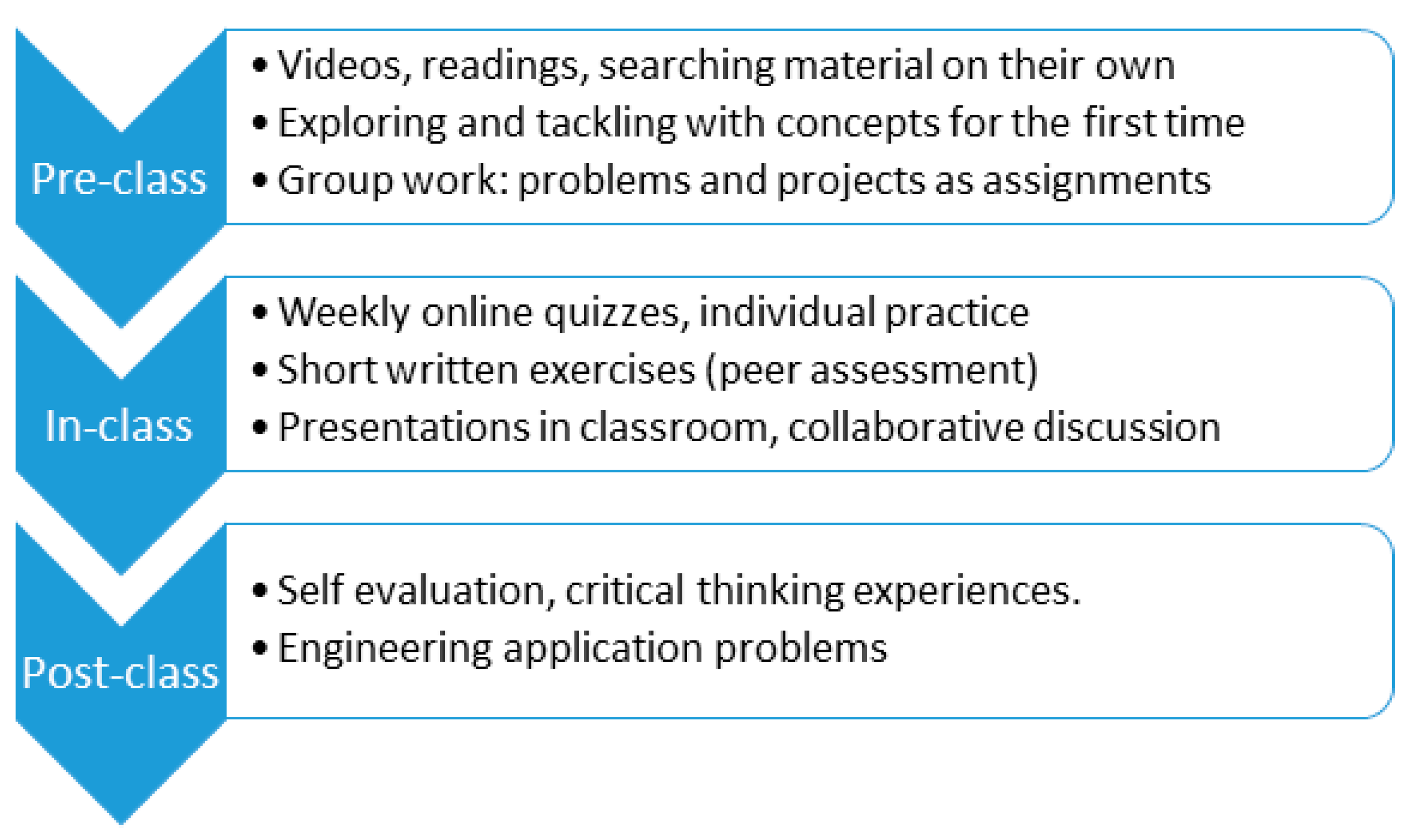
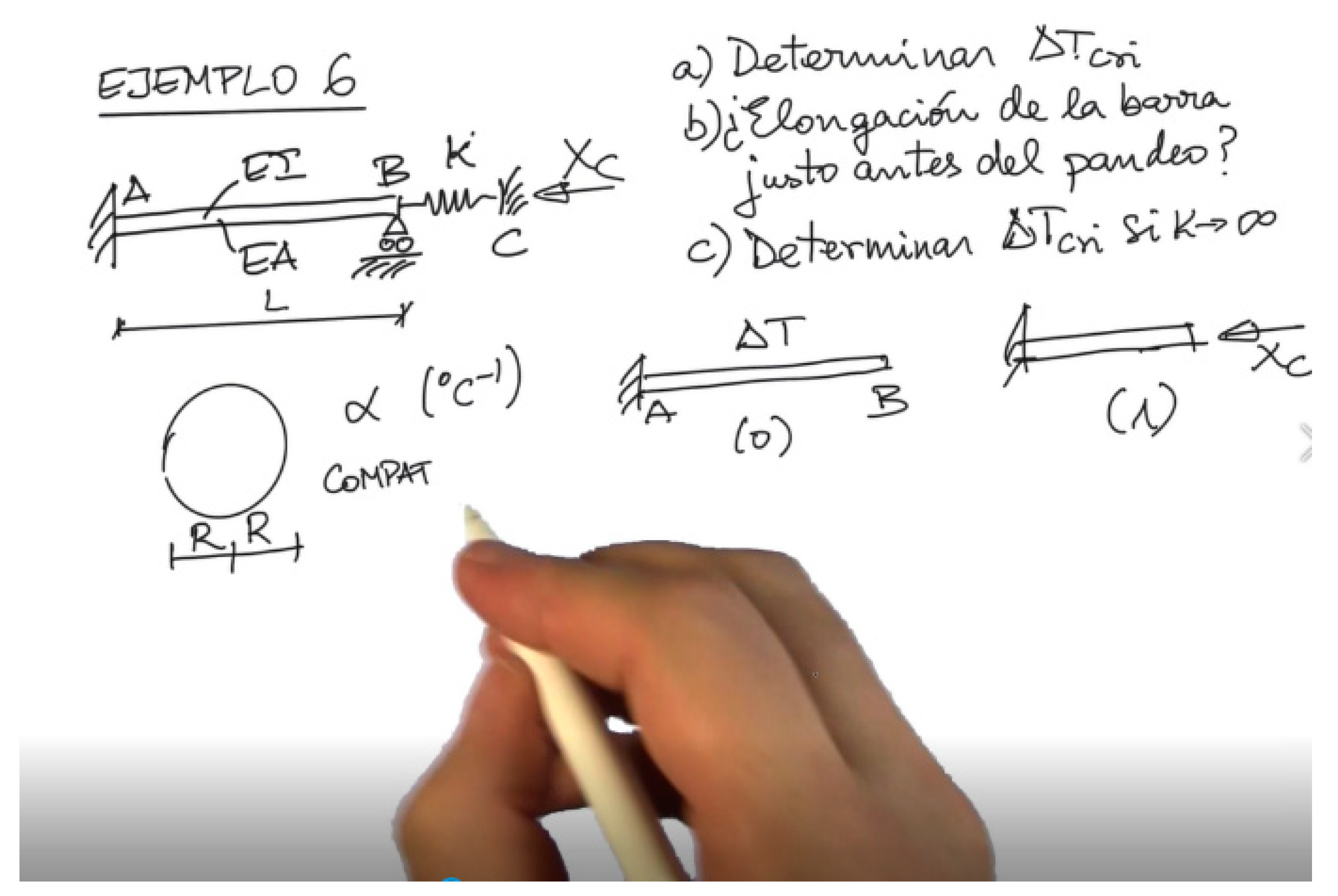
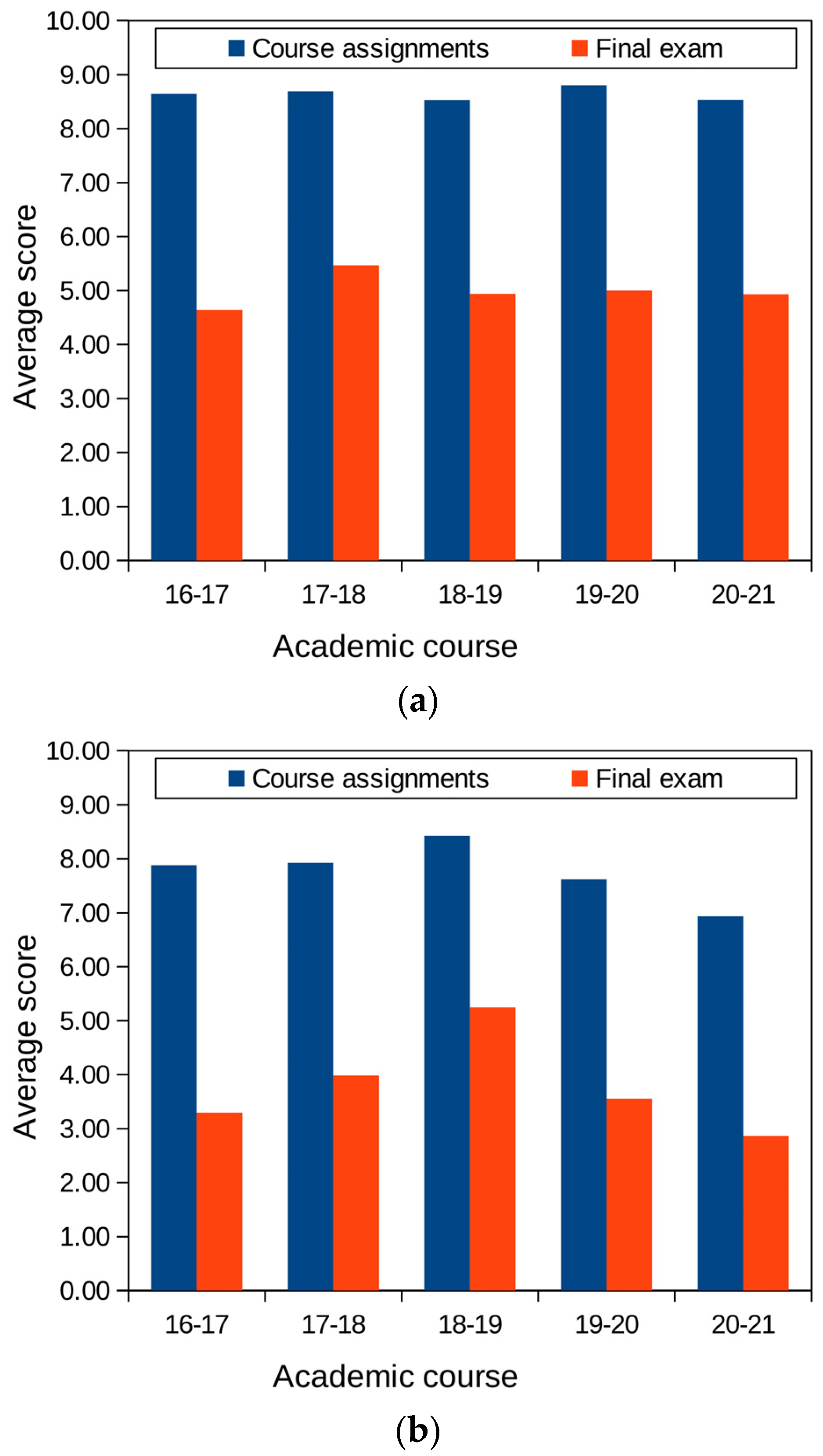
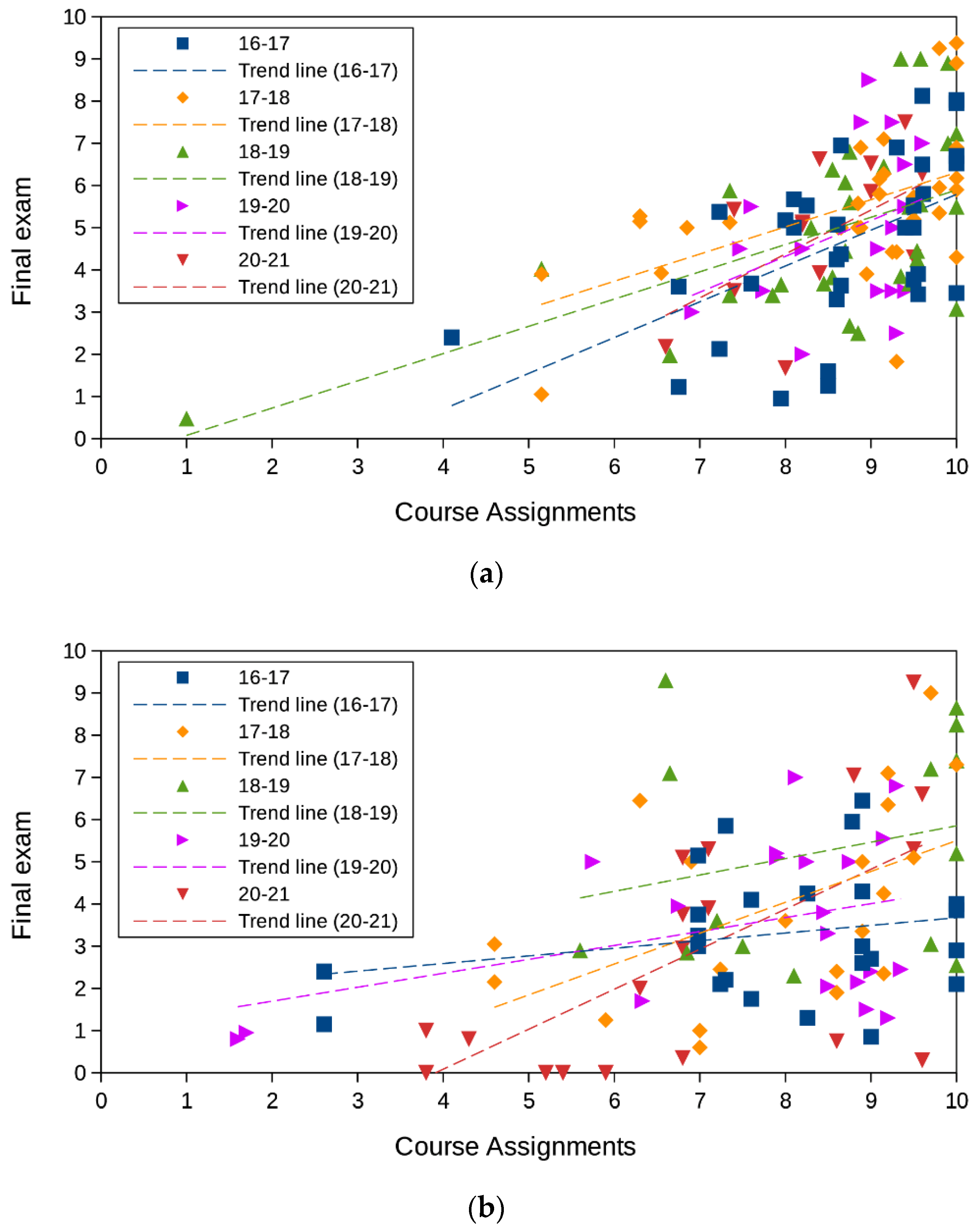

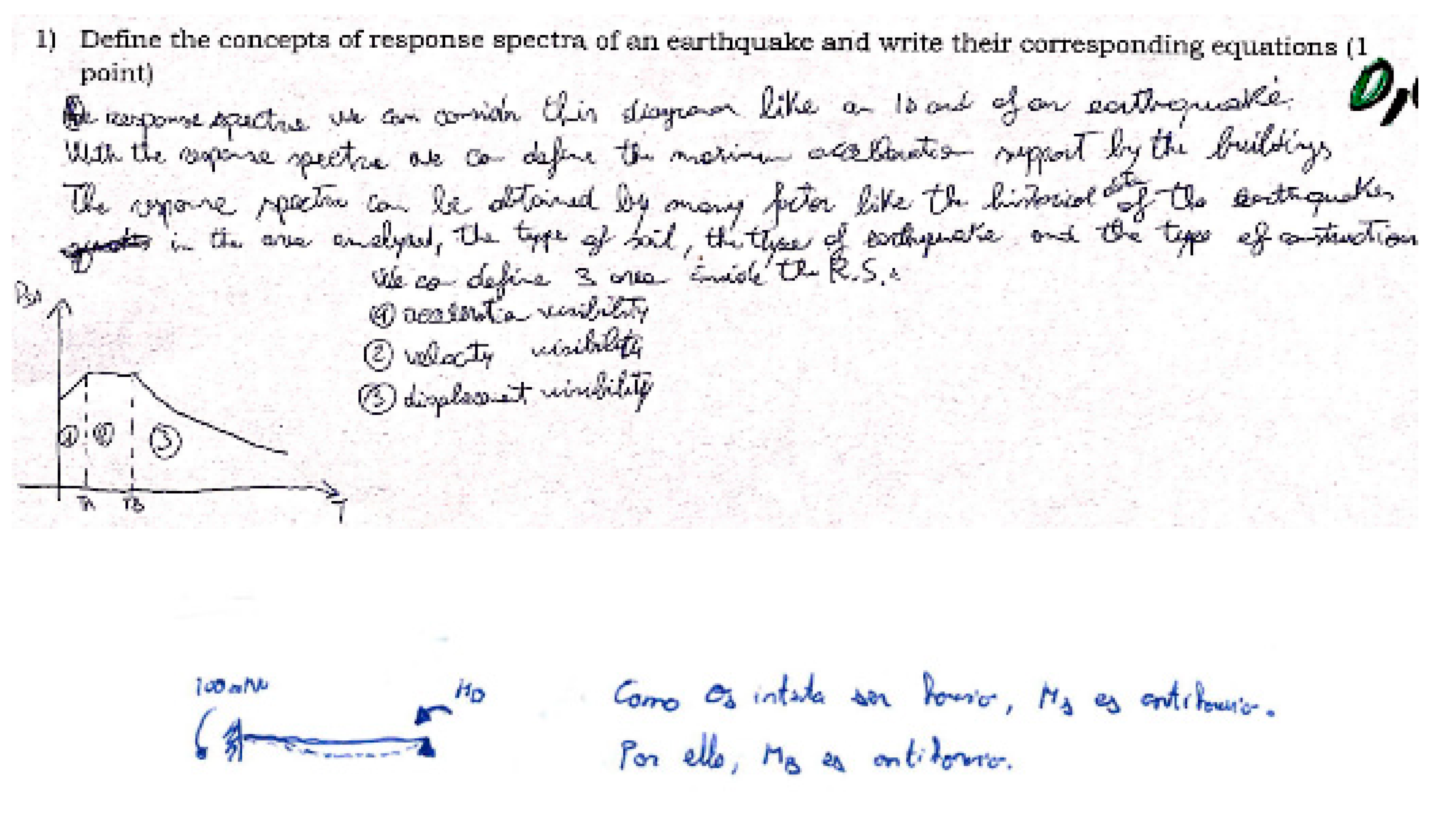
| Theoretical Videos | Solved-Problem Videos | ||
|---|---|---|---|
| Section | Number of Visits | Section | Number of Visits |
| 4.5 | 525 | ||
| 5.1 and 5.2 | 398 | 5.3.1 | 332 |
| 5.3 | 328 | 5.3.2 | 256 |
| 5.4 | 886 | 5.4.1 | 486 |
| 5.4.2 | 1935 | ||
| 5.4.3 | 677 | ||
| 5.4.4 | 589 | ||
| 5.5 | 98 | ||
| 6.3 | 124 | ||
| Registrations | No. of Enrolled Students | No. of Passing Students | Success Rate (%) |
|---|---|---|---|
| Once | 88/86/89 | 10/23/27 | 11.3/26.7/30.3 |
| Twice | 81/65/71 | 27/30/35 | 33.3/46.0/49.2 |
| Three or more | 57/54/65 | 11/20/25 | 19.3/37.0/38.4 |
| Aggregate | 226/205/225 | 48/73/87 | 21.2/35.6/38.6 |
| How Do You Value? | (5) Strongly Agree | (4) | (3) | (2) | (1) Strongly Disagree | Mean | Std Dev |
|---|---|---|---|---|---|---|---|
| That the recent exams became easy? | 0% | 6.8% | 43.2% | 38.6% | 11.4% | 2.45 | 1.32 |
| The adequacy of exams to the module syllabus? | 20% | 48.9% | 22.2% | 8.9% | 0% | 3.80 | 1.31 |
| Your preference about onsite exams vs online | 37.8% | 33.3% | 11.1% | 13.3% | 4.4% | 3.87 | 1.62 |
| The usefulness of CRS on your learning achievements? | 13.6% | 36.4% | 25.0% | 13.6% | 11.4% | 3.27 | 1.71 |
| The usefulness of LMS on your self-paced learning and learning achievements? | 4.7% | 51.2% | 18.6% | 20.9% | 4.7% | 3.30 | 1.52 |
| Your PBL learning achievement during the pandemic? | 17.3% | 28.8% | 34.6% | 17.3% | 1.9% | 3.42 | 1.57 |
| Your degree of satisfaction with the e-resources delivered by the instructors of the module during the lockdown period? | 36.5% | 36.5% | 23.1% | 3.8% | 0% | 4.06 | 1.29 |
| Your certainty on having mastered the key concepts taught in the module? | 11.5% | 36.5% | 42.3% | 9.6% | 0% | 3.50 | 1.38 |
| The amount of learning digital material available for learning during this course? | 56.5% | 43.5% | 0.0% | 0.0% | 0.0% | 4.57 | 0.50 |
| The quality of learning digital material available for learning during this course? | 43.5% | 34.8% | 8.7% | 13.0% | 0.0% | 4.09 | 1.41 |
| The instructor’s module mastery? | 82.6% | 13.0% | 4.3% | 0.0% | 0.0% | 4.78 | 0.67 |
| The instructor’s clarity when teaching? | 65.2% | 26.1% | 8.7% | 0.0% | 0.0% | 4.57 | 0.88 |
| The ambiance, communication and relationship with your classmates in this module? | 39.1% | 34.8% | 26.1% | 0.0% | 0.0% | 4.13 | 1.22 |
| The communication and relationship with your instructors of this module? | 47.8% | 39.1% | 13.0% | 0.0% | 0.0% | 4.35 | 0.98 |
| Your initial readiness and knowledge of fundamentals of this module? | 8.7% | 21.7% | 43.5% | 8.7% | 17.4% | 2.96 | 1.69 |
| The learning effort you have performed in this module? | 26.1% | 52.2% | 17.4% | 0.0% | 4.3% | 3.96 | 1.28 |
| The knowledge outcome you have reached in this module? | 26.1% | 52.2% | 17.4% | 4.3% | 0.0% | 4.00 | 1.16 |
| The fulfilment extent of the learning expectations you have reached? | 34.8% | 43.5% | 13.0% | 8.7% | 0.0% | 4.04 | 1.29 |
| Your degree of satisfaction with your individual engagement in this module? | 17.4% | 52.2% | 17.4% | 8.7% | 4.3% | 3.70 | 1.44 |
| The overall performance of the instructors of this module during this semester? | 65.2% | 26.1% | 8.7% | 0.0% | 0.0% | 4.57 | 0.88 |
| Semester | 2020-I | 2020-II | 2021-I |
|---|---|---|---|
| Number of students | 150 | 152 | 123 |
| % Failing students | 30% | 30% | 27% |
| % Communication mistakes | 42% | 35% | 33% |
Publisher’s Note: MDPI stays neutral with regard to jurisdictional claims in published maps and institutional affiliations. |
© 2021 by the authors. Licensee MDPI, Basel, Switzerland. This article is an open access article distributed under the terms and conditions of the Creative Commons Attribution (CC BY) license (https://creativecommons.org/licenses/by/4.0/).
Share and Cite
Suárez, F.; Mosquera Feijóo, J.C.; Chiyón, I.; Alberti, M.G. Flipped Learning in Engineering Modules Is More Than Watching Videos: The Development of Personal and Professional Skills. Sustainability 2021, 13, 12290. https://doi.org/10.3390/su132112290
Suárez F, Mosquera Feijóo JC, Chiyón I, Alberti MG. Flipped Learning in Engineering Modules Is More Than Watching Videos: The Development of Personal and Professional Skills. Sustainability. 2021; 13(21):12290. https://doi.org/10.3390/su132112290
Chicago/Turabian StyleSuárez, Fernando, Juan Carlos Mosquera Feijóo, Isabel Chiyón, and Marcos García Alberti. 2021. "Flipped Learning in Engineering Modules Is More Than Watching Videos: The Development of Personal and Professional Skills" Sustainability 13, no. 21: 12290. https://doi.org/10.3390/su132112290
APA StyleSuárez, F., Mosquera Feijóo, J. C., Chiyón, I., & Alberti, M. G. (2021). Flipped Learning in Engineering Modules Is More Than Watching Videos: The Development of Personal and Professional Skills. Sustainability, 13(21), 12290. https://doi.org/10.3390/su132112290







